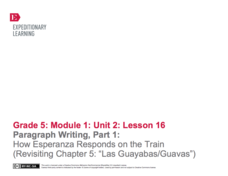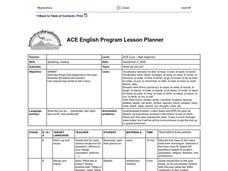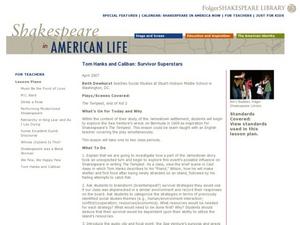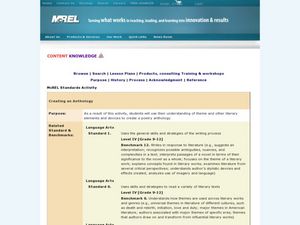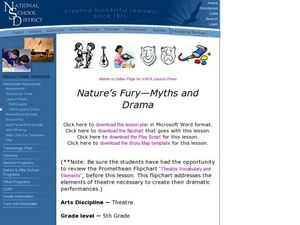Hawaiʻi State Department of Education
Changing Scapes
Culture and art are two things that change with time and context. Learners compare and contrast two landscape prints from different time periods. They work through art terminology to help them describe what they see in each piece. The...
Curated OER
Martin Luther King Jr.
After listening to a story about Martin Luther King Jr., first graders answer questions about the text. They discuss the importance of the illustrations, identify the beginning, middle, and end of the story, and complete a writing...
Curated OER
Lines Composed a Few Miles Above Tintern Abbey
Twelfth graders read lyrics for "My Hometown" and complete a worksheet to identify setting and tone in the song. For this Romanticism lesson, 12th graders read Lines Composed a Few Miles Above Tintern Abbey by Wordsworth and discuss...
EngageNY
End-Of-Unit 2 Assessment: On-Demand Analytical Essay About How Esperanza Changes Over Time
Close the unit on Esperanza Rising with an in-class analytic essay on how Esperanza changes over the course of the novel. Writers can use any of their notes and work from the unit as well as their drafts of the first two paragraphs of...
EngageNY
Paragraph Writing, Part 1: How Esperanza Responds on the Train (Revisiting Chapter 5: "Las Guayabas/Guavas")
When your class members have completed the novel Esperanza Rising, they will be ready to write an expository essay on how Esperanza responds to events and what this says about her character. Set your pupils up for success by...
Hawaiʻi State Department of Education
Poems That Dance
Combine the elements of dance with the actions in a poem. Learners review basic grammar, write an action-packed cinquain poem, and then choreograph a dance based on their cinquains. After the dances are done, they'll discuss the elements...
Curated OER
"Black Boy"
Students read a series of sentences and decide what literary term is being shown. They also discuss a novel about prejudice.
Curated OER
What Did You Do?
English learners practice using the past tense by participating in a time description activity. They identify the differences between verbs when they are used to describe current events or past events. Young scholars answer questions...
Japan Society
Japanese Architecture for High School Students
Japanese architecture is rich in symbolism and culture. Critical thinkers engage in three activities intended to expose them to the beauty of Japan. They read through the book, Praise of Shadows by Junichiro Tanizaki and watch the...
Curated OER
Poetry In Motion
Explore poetry with your class by having them film themselves reading different types of poems. They explore different elements in all types of poetry. They choose images to accompany their poems and learn to create video presentations...
Lunch Lab
Exercise
This is the perfect resource for helping youngsters understand the importance of physical activity in their daily lives. The lesson and its worksheets focus on brainstorming a variety of fitness activities, such as games you can...
Curated OER
The Prince and the Pauper
Mark Twain, the famous American author, is often studied in the school system. Use "The Prince and the Pauper" to analyze the differences between the text and its video version. This lesson includes several culminating project...
Asian Art Museum
Community Identity?
To better understand the contemporary arts movement in Japan, learners engage in a guided discussion. They view several photograms by the artist Kunie Sugirua, then discuss the elements of art and techniques used to create each...
Curated OER
Artistic Symbols
Students compare and contrast symbols used in African and Plains Indian art. In this visual arts lesson, students compare symbols of 2 cultural groups found in their art. Students write a description of what items might have been left...
Curated OER
Personal Poetry: An Introduction to Narrative Poetry
Here are some simple and easy to manage lesson ideas to introduce narrative poetry in your classroom.
Curated OER
Graphs of the Heart
Young scholars study Greek literature. In this Greek tragedies activity, students explore the dance-dramas of Martha Graham. Young scholars study the choreography that brings ancient Greek literature to life.
Curated OER
A Likely and Unlikely Match: Frida and Diego
Delve into the fascinating relationship between Frida Kahlo and Diego Rivera using this resource. Learners discuss the lives of these famous artists, and talk about the ways Frida Kahlo incorporated elements of this tumultuous...
Shakespeare in American Life
Tom Hanks and Caliban: Survivor Superstars
Here’s a clever way to combine language arts and social studies. Shakespeare’s The Tempest is believed to have been inspired by the wreck of the Sea Venture on Bermuda in 1609. The class views a brief scene from Castaway in which Tom...
Curated OER
Polymers all Over the Place
Students investigate properties of common molecules. In this chemistry lesson, students construct polymer models to gain a better understanding of the properties of polymers.
Curated OER
Number the Stars Chapter 15
Students analyze the theme of bravery in the book Number the Stars. They create a list of possible themes in Number the Stars. They review elements of a story, focusing on climax. They debate over the climax of the story.
Curated OER
Clerihew Dances I
Third graders demonstrate locomotor movements and define non-locomotor movement. They discuss a story and perform a "name" movement.
Curated OER
Clerihew Dances II
Third graders explore rhythm and quality of word and phrased to that of dance. They move to the rhythm of poetry.
Curated OER
Creating an Anthology
Student compile a poetry anthology. In this literature lesson, students examine notable poetry anthologies. Students then select a theme to build their anthologies of 10 poems pertaining to their chosen theme.
Curated OER
Nature’s Fury—Myths and Drama
Fifth graders explore the elements of theatre. In this dramatic performances lesson, 5th graders discuss the structural elements of theatre and dramatize "The Origins of the Season," an explanation myth.




